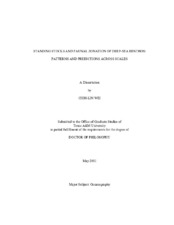| dc.contributor.advisor | Rowe, Gilbert T. | |
| dc.creator | Wei, Chih-Lin | |
| dc.date.accessioned | 2012-07-16T15:57:15Z | |
| dc.date.accessioned | 2012-07-16T20:26:39Z | |
| dc.date.available | 2012-07-16T15:57:15Z | |
| dc.date.available | 2012-07-16T20:26:39Z | |
| dc.date.created | 2011-05 | |
| dc.date.issued | 2012-07-16 | |
| dc.date.submitted | May 2011 | |
| dc.identifier.uri | https://hdl.handle.net/1969.1/ETD-TAMU-2011-05-9423 | |
| dc.description.abstract | The deep ocean (> 200-m depth) covers more than 65 percent of earth's surface and is known as the largest active carbon sink of the planet. Photosynthesis fixes inorganic carbon into organic rich-compounds to fuel the biological production in the upper ocean. A small portion of the photosynthetic carbon eventually sinks to the seafloor to support diverse deep-sea life. In this dissertation, the phytoplankton production and export flux of particulate organic carbon (POC) to the seafloor were linked to standing stocks and compositional changes of the deep-sea soft bottom assemblages. The pattern and processes of energy transfer from the surface ocean to the deep sea was examined by modeling the global benthic bacteria, meiofauna, macrofauna, and megafauna biomass from remotely sensed ocean color images and the seafloor relief. The analysis was then scaled down to the macrofauna of the Gulf of Mexico (GoM) to examine the global pattern on regional oceanic features with contrasting productivity regimes. These results suggested a universal decline of benthic standing stocks down the continental margins that is caused by an exponential decrease of export POC flux with depth. A revisit of historical epibenthic invertebrate sampling in the North Atlantic showed that both individual species and multi-species assemblages occurred in narrow depth bands that hugged the topography from the upper continental slope out to the Hatteras Abyssal Plain. The continuum compositional change suggested that the continuous decline of benthic food supply with depth was the potential driving force for the pattern of bathymetric faunal zonation. A broad, systematic survey across multiple depth transects in the northern GoM suggested that macrofauna zonation is not only taking place across isobaths, but also form the northeast to the northwest GoM due to a horizontal productivity gradient created by the nutrient-laden Mississippi River. Analyses of long-term demersal fish data from 1964 to 2002 in the northern GoM showed no evidence of large-scale faunal change across different sampling times. Base on the pooled data, a shift in rate of fish species replacement may be caused by complex biological interactions or changes in environmental heterogeneity along depth or productivity gradients. | en |
| dc.format.mimetype | application/pdf | |
| dc.language.iso | en_US | |
| dc.subject | deep sea | en |
| dc.subject | standing stocks | en |
| dc.subject | abundance | en |
| dc.subject | biomass | en |
| dc.subject | faunal zonation | en |
| dc.subject | epibenthic invertebrates | en |
| dc.subject | demersal fishes | en |
| dc.subject | macrofauna | en |
| dc.subject | global pattern | en |
| dc.subject | Gulf of Mexico | en |
| dc.subject | North Atlantic | en |
| dc.title | Standing Stocks and Faunal Zonation of Deep-Sea Benthos: Patterns and Predictions across Scales | en |
| dc.type | Thesis | en |
| thesis.degree.department | Oceanography | en |
| thesis.degree.discipline | Oceanography | en |
| thesis.degree.grantor | Texas A&M University | en |
| thesis.degree.name | Doctor of Philosophy | en |
| thesis.degree.level | Doctoral | en |
| dc.contributor.committeeMember | Rooker, Jay R. | |
| dc.contributor.committeeMember | Quigg, Antonietta | |
| dc.contributor.committeeMember | Thornton, Daniel C. | |
| dc.type.genre | thesis | en |
| dc.type.material | text | en |


